A community of amateur radio enthusiasts, including the team at DX Engineering, work together to turn a bold idea into reality.
This article was contributed by friend of OnAllBands Kees Van Oosbree, W0AAE.)
***
Amateur radio operators have always strived to advance the radio art. It is the framework by which the Federal Communications Commission (FCC) judges the continuation of the amateur radio service, stated specifically in its Part 97 rules. I see many emails on amateur radio email reflectors each on different facets of the hobby, asking how hams can continue to “advance the radio art” in the age of the internet and social media.
How do we attract more people (and specifically younger people) to this hobby? This is not an easy question to answer.
But my involvement in the social media platform YouTube contributed to ideas of how to attract younger people. I see creators on YouTube doing crazy things to actively attract a greater audience on their channels, such as running trains off into a pit, conducting experiments with 50-caliber rifles to see a bullet’s penetration through different materials, and many more eccentric projects. I wanted to take that same concept of “doing something crazy” to push the limits of what is possible in amateur radio to attract the younger generation.
I had always been interested in bodies of water, maritime traffic, and lighthouses. While I live in Minnesota, our lakes— and specifically Lake Superior—are our greatest pride. I began looking for a man-made structure in Lake Superior where I could set up a remote HF station where youth operators and the scientific community would be able to remote in and use whenever they wanted. Although I considered Stannard Rock Lighthouse—often called the “loneliest place in North America” and recognized as one of the top-ten engineering feats in the United States—the site had already been activated by hams, and its limited internet and power infrastructure made it unsuitable for supporting a permanent remote station. With the lighthouse also being so far north and surrounded in freshwater, the propagational advantage was not enough to warrant such an extensive operation. It was too crazy of an idea for my still-teenage self. I abandoned the idea quickly.
In early August 2023, I came across a YouTube video about Frying Pan Tower—a structure standing in the middle of the Atlantic Ocean in fifty feet of water on Frying Pan Shoals, 32 miles off the coast of Southport, North Carolina, in international waters.
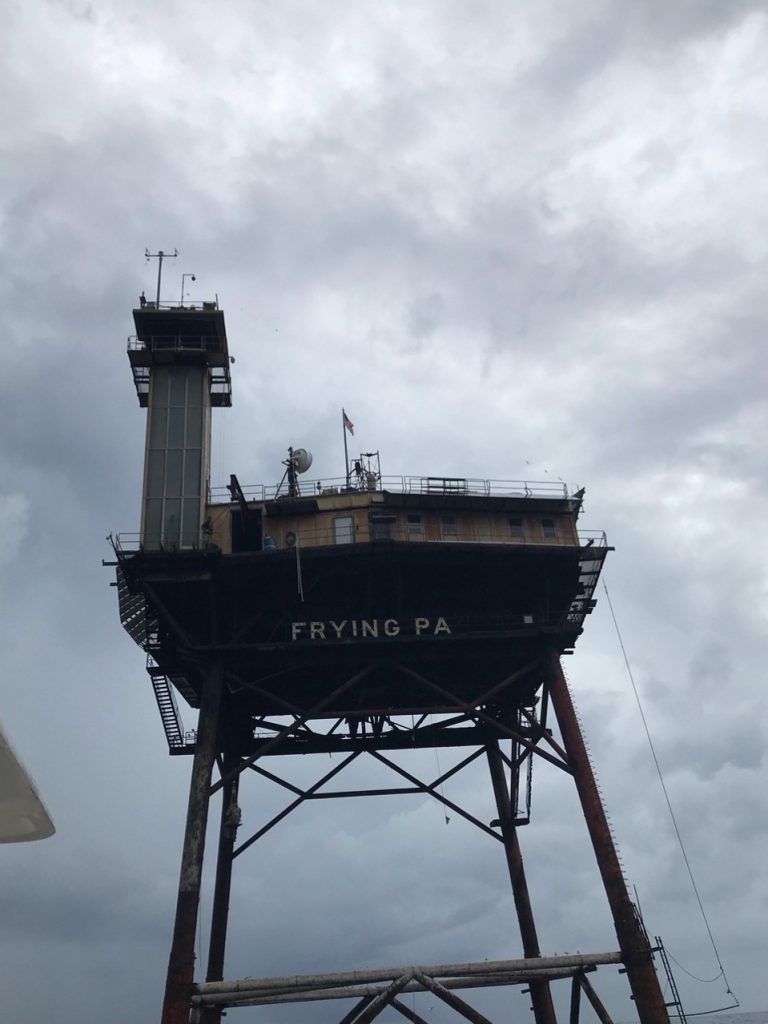
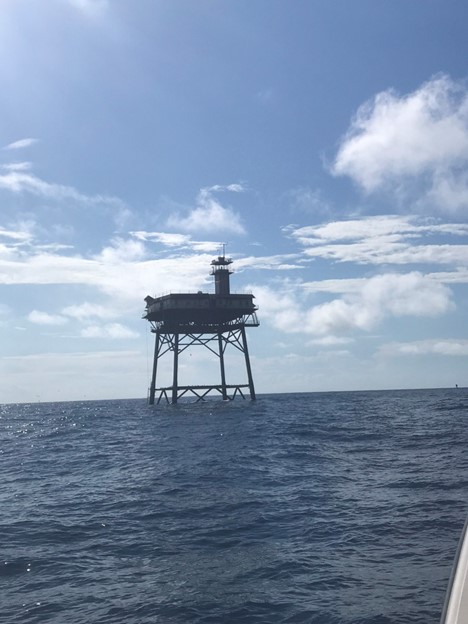
I learned that the tower was run by Richard Neal, who bid on the tower in a closed auction from the U.S. government in 2010 and turned the conservation of the tower into a nonprofit. Three factors stood out about the tower and its possibilities for constructing a remote station on it: propagation, electricity, and internet.
- The tower is surrounded by saltwater and is relatively close to Europe, a perfect habitat for exploration of propagation.
- The tower utilizes solar cells for its renewable energy resource, ensuring that the remote station is working even when volunteers are not present at the tower.
- The tower has a reliable internet, with a 100 Mbps download speed from a microwave link to a 1,500-foot media tower on land.
After emailing Richard about the possibility of building a remote HF station on Frying Pan Tower, he responded with excitement, mentioning that he planned to take his Technician class license exam later that year. He is now KQ4NRF and is working on his General class license. While I had his permission, the reality set in: As a college freshman, finding the materials and funding for such an operation would be a challenge. I needed a mentor. I kept the project in the back of my mind for the next year and a half.
In December 2024, I reached out to Gregg, W6IZT, an experienced DXpeditioner who had just led the youth remote DXpedition to Rotuma that November and December. Although he could not join a Frying Pan Tower trip due to other DXpedition commitments in 2025, he connected me with Nathan, K4NHW—a fellow participant in the same Rotuma DXpedition with extensive DXpedition experience and a long-standing interest in visiting the tower.
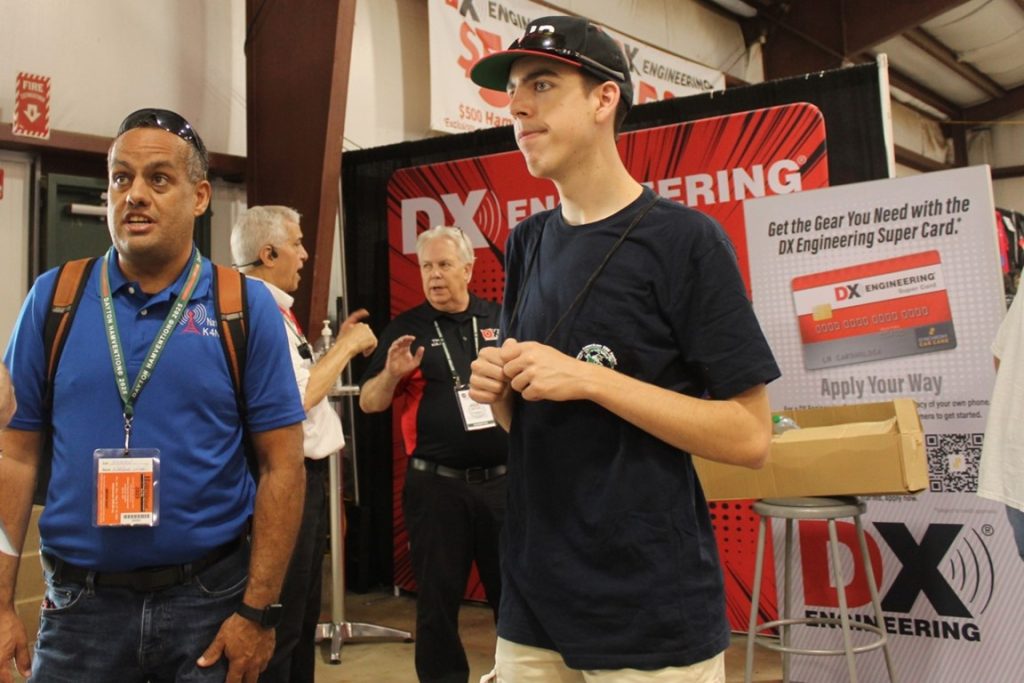
Nathan and I set up a Zoom meeting with Richard in early January 2025 to discuss antenna and equipment placement and to gauge a timeline as to when Nathan and I could venture out to the tower. We agreed that an end-fed half-wave (EFHW) and an 80M fiberglass vertical were the best antennas suited for a tower exposed to a corrosive saltwater environment and pounded by winds and hurricanes. Because of our experience with FlexRadio, Nathan agreed to donate to the remote station a Flex 6400 that he was not using at the time. We scheduled July 10-14 as the days Nathan and I would set up the station on the tower.
Since Nathan lived within driving distance of the marina in Southport from his home near Atlanta, we agreed that he would handle all testing and setup of the remote station. I cannot overstate the impact Nathan had on this project. His experience with Node-RED and remote station hardware design was invaluable to ensuring this project would succeed, especially when we had one shot at making sure it worked on the tower.
I took charge of publicity and funding for the project, reaching out to Tim Duffy, K3LR, to share our plans and explore the possibility of DX Engineering sponsoring equipment. DX Engineering exceeded all expectations. After we sent them a list that included coax, antennas, wire, remote antenna tuners, and lightning protection, they had everything delivered to us within three days.
We still needed funds for transportation and other miscellaneous expenses. Nathan and I reached out to contacts familiar with amateur radio grants and were soon connected with Ward Silver, N0AX, president of the Yasme Foundation—a nonprofit dedicated to advancing amateur radio worldwide through technical innovation, education, and fostering international goodwill. The foundation awards grants, recognizes excellence, and helps fund DXpeditions and other initiatives that promote the amateur radio service. Thanks to their generosity, we received a sizable donation, for which we are deeply grateful. This project would not have been possible without DX Engineering and the Yasme Foundation, whose support covered the expenses of such an operation and made it possible for us to experiment and pursue this ambitious undertaking.
July came, and Nathan and I were ready to go out to the tower. However, the forecast for July 10 brought poor weather and high waves. With an almost two-hour boat trip out to the tower, the captain of our boat decided to postpone the trip. The next available date to go out to the tower was August 7. I flew into Wilmington, North Carolina, on August 6, while Nathan drove from Atlanta with all of the gear. We arrived at the marina in Southport at around 6 am and arrived at the tower two hours later with nine other tourists and volunteers. Due to the lack of stairs going up to the platform of Frying Pan Tower, a hoist is used to lift all goods contained in Pelican Cases 80 feet up to the helicopter platform. Nathan and I were lifted up with the hoist separately.
We immediately began setting up the station—a Flex 6400, router, and servers for remote operation.
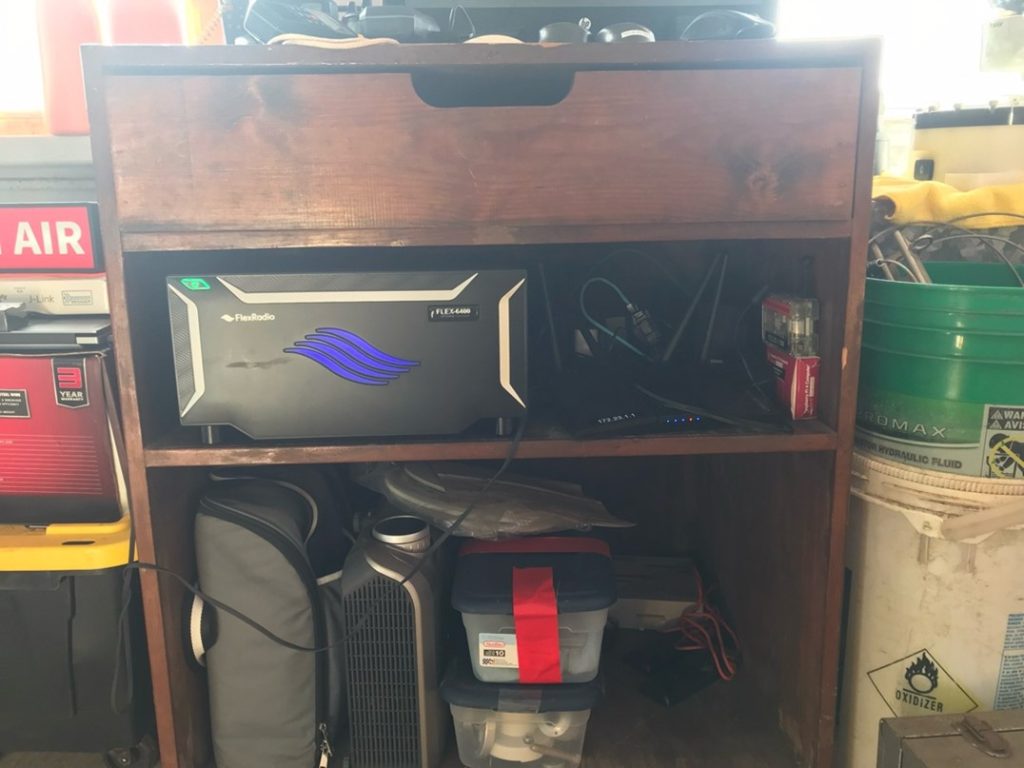
Thanks to Nathan’s effort on both the hardware and software, the network came online flawlessly on the first try. Unfortunately, Richard informed us that the microwave internet link from the onshore communications tower, which routinely allowed 100 Mbps upload and download speeds from the tower, had gone down the day before due to a power failure. With no qualified climbers available to service the communications tower, we had to rely on a spotty 5 Mbps cellular hotspot connection for internet access.
On the helipad, we deployed the EFHW antenna, with Richard securing one end to the top of the beacon structure. The 49:1 balun and LDG remote antenna tuner were housed in a weather-protected PVC enclosure. Although this configuration was intended only as a temporary solution to bring the station on the air as K4F/MM using FT8, we knew that both the EFHW and the Flex 6400 would eventually require a more permanent installation. For the time being, however, we assembled a functional station as quickly as possible so we could begin handing out QSOs from the rare FM13 grid square, while also starting construction of the 80M vertical antenna wound around a 12-meter Spiderpole fiberglass mast.
The operating conditions from the tower were remarkable. Despite a little noise during the daytime caused by the tower’s solar panels, band openings were excellent, and over the course of our five-day stay we logged approximately 1,150 QSOs—about 95% of them on FT8. The reliance on FT8 was largely due to the amount of time spent troubleshooting antenna placement issues and engaging in social activities (like fishing and cornhole) with other volunteers and visitors at the tower.
Nathan even brought his satellite equipment (below) so we could make a few QSOs on the birds from the rare FM13 grid.
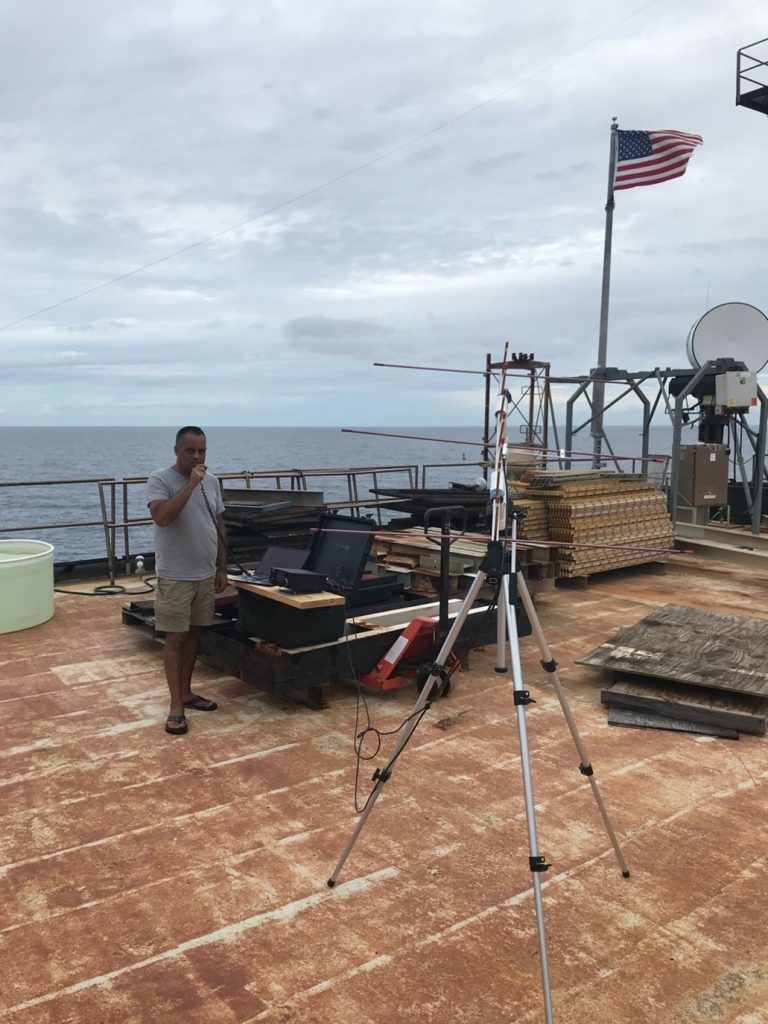
Even so, performance on the air was impressive: We made reliable long-path QSOs to Australia on just 10 watts, and the lower bands outperformed the higher ones on the EFHW. In particular, 40 meters was outstanding, with consistent 59+20 reports from East Coast stations while running less than 100 watts on sideband. We had another youth from Pennsylvania remote into the station on our poor cellular internet, and even he was impressed with how well it performed.
After many days of experimenting with SWR on the different bands with the EFHW and on different locations on the tower, we settled on the eastern side of the tower for our permanent installation. The volunteer crew was absolutely fantastic in helping mount the EFHW. Many of them had prior CB experience, which gave them enough familiarity with radio terminology to understand the basics of what we were trying to accomplish. They exceeded all expectations, particularly in designing supports capable of withstanding the harsh environmental conditions the antenna was subjected to. After choosing our permanent location, a crew member named Josh was able to weld a stainless steel pipe onto a solar panel support to act as a mast for the EFHW (below). It was not easy to mount anything during the winds that would reach upwards of 30 miles per hour, but after many hours of experimentation, the EFHW was permanently installed on the last day before we left.
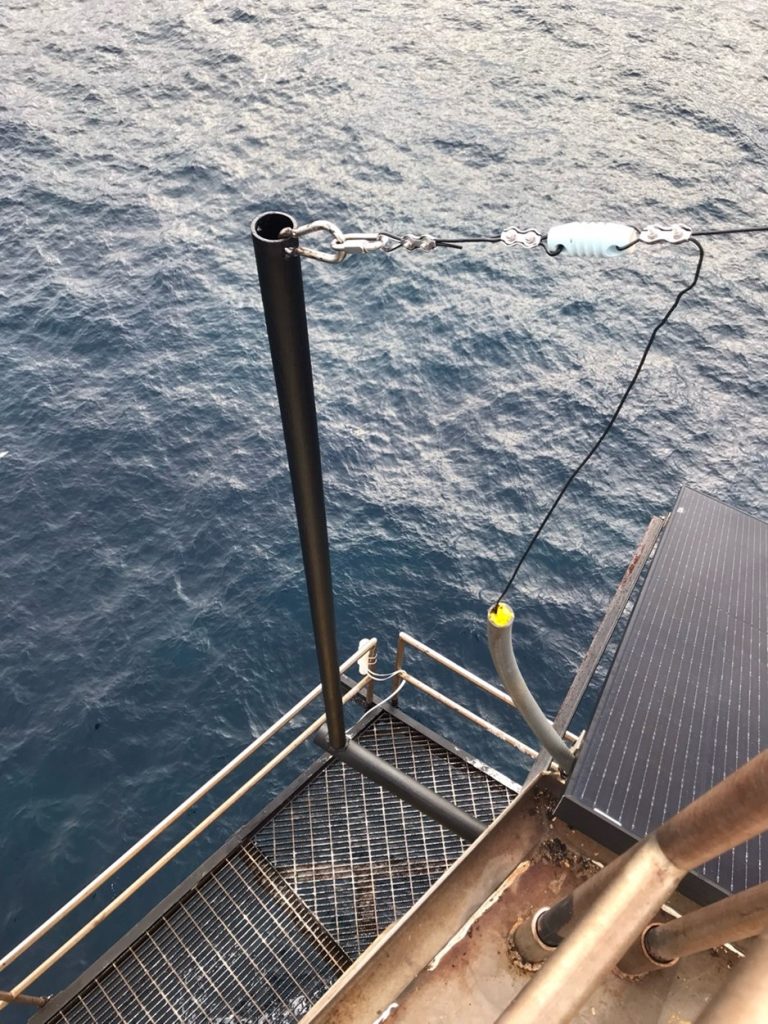
Unfortunately, we were not able to accomplish putting up the 80M vertical before we left. After surveying the beacon portion of the tower where the vertical would be placed, we concurred that another trip would need to be made to the tower. The beacon portion of the tower is currently being restored with a new roof, and it just wasn’t feasible to put an antenna up during the time that we were out there. The EFHW is resonant at the bottom of the 80M band, so that will have to do until another trip is planned.
Our time on Frying Pan Tower proved that ambitious ideas in amateur radio can be transformed into reality with the right mix of teamwork, mentorship, and support from the wider community. What began as a bold concept evolved into a functioning remote station, built under challenging conditions and made possible through the generosity of organizations like DX Engineering and the Yasme Foundation.
While there is still work to be done—including the installation of the 80M vertical and further refinements to the remote system—this first expedition laid the foundation for long-term operations from one of the most unique amateur radio sites in the world. More importantly, it demonstrated the spirit of experimentation and collaboration that defines our hobby and continues to “advance the radio art.”
Nathan, K4NHW and Kees, W0AAE would like to thank the Yasme Foundation and DX Engineering for their extremely generous support of this project. Without their help and confidence in us, this project might never have happened. We also want to thank Richard Neal for opening Frying Pan Tower up for experimentation. We hope this collaboration will encourage amateur radio opportunities on the tower for years to come.
If you would like to show support for the nonprofit organization responsible for restoring the tower, check out fptower.org for more information.

